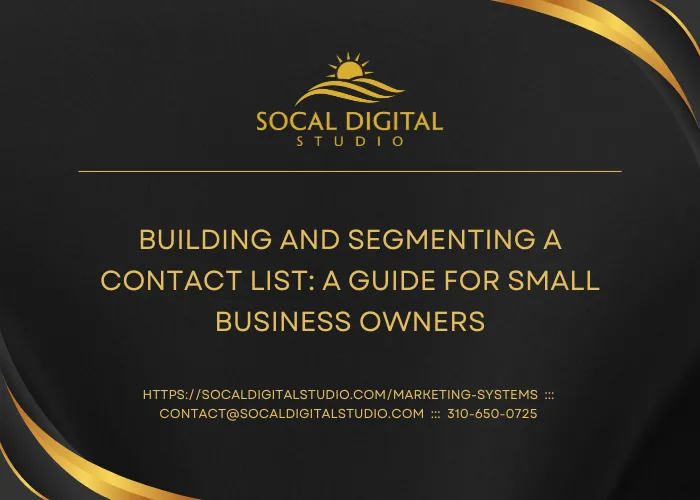PROPELLING SUCCESSFUL BUSINESSES
Actionable Best Practices

Building and Segmenting a Contact List: A Guide for Small Business Owners
“Communication is merely an exchange of information, but connection is an exchange of our humanity.” - Sean Stephenson
Introduction
For small businesses, having a well-organized and segmented contact list can be a game-changer. This essential asset not only improves the efficiency of marketing efforts but also enhances customer relationships and boosts conversion rates. Here’s a comprehensive guide on how to build a contact list, why segmentation is crucial, and how to go about it effectively.

Building a Contact List
1. Choose the Right Tools: First and foremost, select a customer relationship management (CRM) system that fits your business size and needs. Choose one that aligns with your marketing goals and is user-friendly.
2. Collect Contact Information: Start by collecting contact information through various channels:
Website Forms: Incorporate subscription forms on your website. Use pop-ups, sidebar forms, or footer forms to encourage visitors to subscribe.
Social Media: Utilize your social media platforms to invite followers to join your mailing list. Offer incentives like discounts or free content for those who sign up.
Offline Methods: Collect contacts at trade shows, networking events, or local meetups. Ensure you follow up promptly to keep the interaction fresh in their minds.
3. Offer Value: People are more likely to give their information if they receive something valuable in return. This could be access to exclusive content, a free webinar, or a discount on their first purchase.
4. Ensure Compliance: Always comply with data protection laws like GDPR or CCPA. Make sure your forms have clear privacy policies and opt-in methods.
Why Segment Your Contact List
Segmentation involves dividing your contact list into smaller groups based on specific criteria to tailor marketing efforts more precisely. Here’s why it’s essential:
1. Targeted Communication: Segmentation allows for more personalized communication, which can significantly increase engagement rates. Emails targeted to a specific segment can have a 100% higher click-through rate than non-segmented emails.
2. Improved Customer Retention: By addressing the specific needs and interests of different segments, you enhance customer satisfaction and loyalty.
3. Efficient Resource Allocation: Focusing your marketing efforts on segments more likely to convert can lead to a better allocation of resources and higher ROI.
4. Better Tracking and Optimization: Segmentation enables you to track the performance of various segments and adjust strategies accordingly.
How to Perform Segmentation
1. Demographic Segmentation: Divide your list based on demographic information such as age, gender, occupation, or education level. For instance, a boutique might segment customers into different age groups to promote age-appropriate fashion lines.
2. Geographic Segmentation: This involves segmenting your contacts based on their location. A restaurant chain, for example, might send different menu promotions to customers living in different cities or regions.
3. Behavioral Segmentation: Segment based on customer behaviors such as purchase history, website activity, or engagement with previous campaigns. For example, an online bookstore could target frequent purchasers with loyalty program offers, while occasional buyers might receive discount offers to boost their purchase frequency.
4. Psychographic Segmentation: This segmentation focuses on interests, lifestyles, or values. A fitness center might create segments for those interested in weight loss, bodybuilding, or general fitness, offering tailored content and class promotions that resonate with each group’s interests.
Conclusion
Building and segmenting a contact list are critical for maximizing the effectiveness of marketing efforts in a small business. By following these steps and continuously refining your approach based on feedback and performance metrics, you can create a powerful marketing tool that drives engagement, improves customer retention, and increases sales. Start small, think strategically, and scale your efforts as you gather more data and insights about your customers.
We Will Help Build Your Contact List and Segment It
To craft an effective digital marketing plan for your firm that includes building your contact list, schedule a free impact and strategic session with us by CLICKING HERE and discover cutting-edge ways to optimally use your marketing resources in the most effective and results-driven activities.
Recommended Reading: "This is Marketing" by Seth Godin.

SUBSCRIBE TO THIS NEWSLETTER TO STAY IN THE KNOW
Please contact us with topics you would like us to cover
Dominate with Our Affordable All-in-One Marketing System
SoCal Digital Studio's Advanced All-In-One Marketing System is built to help local businesses attract, engage, convert, and retain customers with speed and consistency. It automates the communication that is essential to a business' success and continuing growth. Request a free marketing audit to uncover weaknesses and use SoCal Digital Studio's Marketing System to not only compete, but dominate the market.
All-in-One Marketing System
Leverage Powerful Marketing Tools and Sales Funnels to Nurture and Convert Customers at an Affordable Price
Our marketing system has it all and allows you to (1) capture leads via landing pages, forms, calendars, and inbound phone calls; (2) message leads via phone calls, SMS, emails, and Messenger; and (3) close leads with built-in tools for payments and analytics (including call tracking).You can also create landing pages and funnels, set up automated follow-up campaigns, schedule appointments, fine-tune marketing and sales processes, and manage all of it so nothing slips between the cracks in your dedicated marketing system.
Stellar Package
Monthly Subscription
12-Month Subscription is $4970
One-Time Set-Up Fee Varies
$297
Full System Access
5,000 Contacts
1,500 SMS or Calls
15,000 Emails
1-3 Team Members
Galactic Package
Monthly Subscription
12-Month Subscription is $6970
One-Time Set-Up Fee Varies
$497
Full System Access
7,500 Contacts
3,000 SMS or Calls
30,000 Emails
4-10 Team Members
Cosmic Package
Monthly Subscription
12-Month Subscription Is $9970
One-Time Set-Up Fee Varies
$697
Full System Access
10,000 Contacts
4,500 SMS or Calls
45,000 Emails
11-15 Team Members
